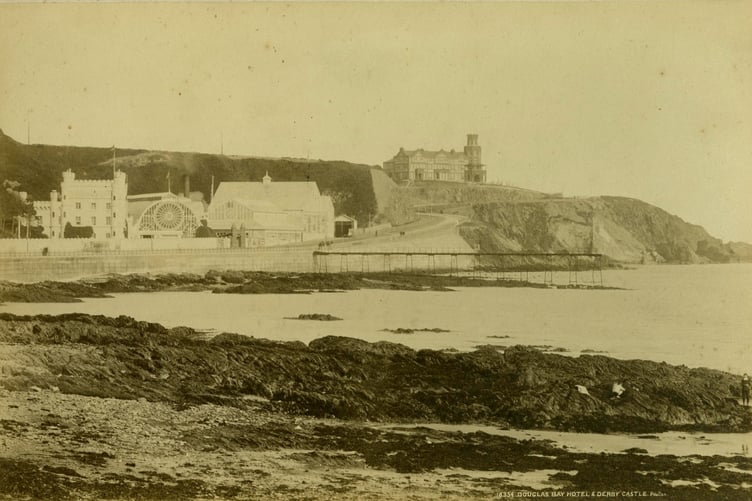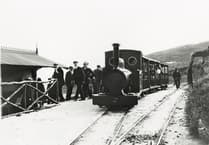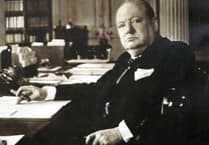I am old enough to remember the Derby Castle site at the far northern end of Douglas Promenade and vaguely think I attended a show performed by Josef Karma, ‘The Lightning Hypnotist’…
The site was originally owned by the fourth Duke of Atholl, who in 1822 developed the land and subsequently built Strathallan Crescent.
In 1831, his estate was sold to a retired military man, Major Samuel Pollock.
By 1837, Pollock had built Strathallan Lodge - now the site of the Terminus Tavern pub - as his private residence, along with the castellated building named Derby Castle, which was occupied by a succession of tenants over the next 40 years.
In 1876, the Derby Castle estate was purchased by Alfred N. Laughton, a lawyer from Yorkshire who was a long-term Douglas resident.
In the late 19th century, the Isle of Man tourism industry was expanding, and Laughton decided to create a pleasure park in the grounds of the Derby Castle and turn the building into a hotel.
To finance the venture, Laughton formed a private company in 1878 with six businessmen and called it the Derby Castle Hotel and Pleasure Grounds Company.
As Isle of Man tourism developed quickly, the Derby Castle needed to expand to compete with others seizing similar opportunities.
To finance this expansion, Laughton decided to turn the company into a public one with ninety other businessmen, and thus in 1884, the Derby Castle Company Limited was created.
A new pavilion was built in the grounds, designed by Douglas architect William R. Rennison.
It contained a ballroom and theatre with multiple attractions including gardens, a type of roller coaster, a swimming bath for aquatic exhibitions, and fireworks displays.
An original partner of the dissolved Derby Castle Hotel and Pleasure Grounds Company was John A. Brown, who—as I have previously mentioned—was editor and proprietor of the Isle of Man Weekly Times and Daily Times.
In the 1880s, Brown branched out on his own into the entertainment industry. He was chairman of the Manx Syndicate, which was formed in 1888 and acquired the Castle Mona estate, turning it into the Palace entertainment complex.
By the 1890s, competition was stiff among the island’s entertainment businesses, with numerous Douglas venues such as the Derby Castle, the Palace Ballroom, the Marina Pavilion (later the Gaiety Theatre), and the Falcon Cliff. The result of this competition caused the value of Derby Castle Hotel and Pleasure Grounds Company Limited shares to halve.
It was decided that a merger of the entertainment companies was necessary if the island’s tourist industry was to survive.
Therefore, in 1898, and under the leadership of John Brown, the company incorporated Derby Castle, the Palace Ballroom, the Marina Pavilion, and the Falcon Cliff to form the Palace and Derby Castle Company Limited. Later incorporations and developments included venues such as the White City amusement park on Onchan Head, the Grand Theatre, the new Palace Opera House (now the Palace Cinema), and numerous cinemas and dance halls around the island.
Early performers at the Palace and Derby Castle Company venues included Marie Lloyd, Vesta Tilley, Florrie Ford and Harry Lauder.
During the two world wars, the Palace and Derby Castle Company properties were utilised for wartime efforts. For example, during the First World War, the Derby Castle ballroom was used as a factory to produce garments and airship ballonets.
In the Second World War, this property was used to store carpets and floor coverings from seafront hotels and guesthouses. This was because, in the words of Connery Chappell in ‘Island of Barbed Wire’, many of the hotels and guesthouses were used as internment camps for enemy aliens.
The late 1940s saw a resurgence in island tourism; however, even by the late 1950s and 1960s, the tourist trade faced competition from cheap package holidays offering modern guest facilities and guaranteed sunshine in Mediterranean destinations.
By the late 1960s and beyond, the company reduced its activities, but those of us fortunate enough to live through that era on our island enjoyed the best current bands—notably in the Palace Lido on a Sunday night, but also in the municipal venue of the Villa Marina.
Summer shows and cabarets continued at a number of venues including the Gaiety Theatre, the Palace Hotel and Casino, the Villiers Hotel, the Falcon Cliff, Talk of the Town (Ramsey), the Crescent, and many more.
Who remembers the biweekly cabarets with The Grumbleweeds, Frank Carson, and of course, one of my favourite vocalists, Tony Christie, who returned recently with a great performance at the Gaiety?
All the top bands—too many to mention—entertained us, including The Rolling Stones, T. Rex, Slade, Queen, Sweet, Procol Harum, AC/DC, Thin Lizzy, 10cc, Mott the Hoople, Status Quo, Hawkwind, Cream, Judas Priest, Pink Floyd, Jeff Beck, The Who, The Kinks, Small Faces, and more… How lucky were we?
And that’s without even mentioning all the top Manx bands we enjoyed.

---------------------------------------------
I’m a big supporter of the economic potential and many benefits for the local population that come with a vibrant tourist industry—especially in an uncertain world.
I recently researched one of the island’s beautiful glens. We are fortunate to have 18 national glens, top sporting facilities at the National Sports Centre, and eight golf courses around the island. We have a rich history, heritage, natural environment, and culture—with Viking influence, Manx music, and dance as vibrant as I can recall in my lifetime.
The Millennium Way from Ramsey to Castletown and the Raad ny Foillan (coastal footpath), along with many scenic public footpaths, benefit from a recently renewed Tynwald commitment to their maintenance.
Our heritage railway system includes the narrow-gauge steam railway between Douglas and Port Erin, enthusiast-operated lines at Laxey, Groudle, and the Wildlife Park, and the unique Manx Electric Railway—running for more than 130 years from Douglas to Ramsey—and the Snaefell Mountain Railway.
We already have a range of special sporting and cultural events to build upon. Well done on the exciting skateboard event recently—an ideal fit.
What did the Victorians ever do for us? Lots! What about the Camera Obscura or Laxey Wheel?
With the horse tram 150th anniversary coming next year, surely it makes sense to commit to completing the full length.
Then there’s the Isle of Man's speciality foods, including the best ice cream anywhere, pure beer still brewed to the strict criteria of the 1874 Manx Brewers’ Act, the finest Manx honey from disease-free Manx bees, delicious queenies, Manx kippers (better than any competitor), and a range of award-winning cheeses. We can certainly outdo others in terms of food miles and traceability.
Of course, we are the road race capital of the world.
I hope everyone enjoys the Manx Grand Prix and Classic TT! Any motorsport enthusiast—car or bike—admires the historical significance of the TT course and being part of the event.
As Minister of Tourism and Leisure for 10 years, I was interested to read suggestions that the industry could be better served by returning to having a minister responsible for all the features so special and unique to our island—including those mentioned above—and by maximising the visitor economy through further cooperation with the Steam Packet and airlines.
What do you think?

.jpg?width=209&height=140&crop=209:145,smart&quality=75)
.png?width=209&height=140&crop=209:145,smart&quality=75)

